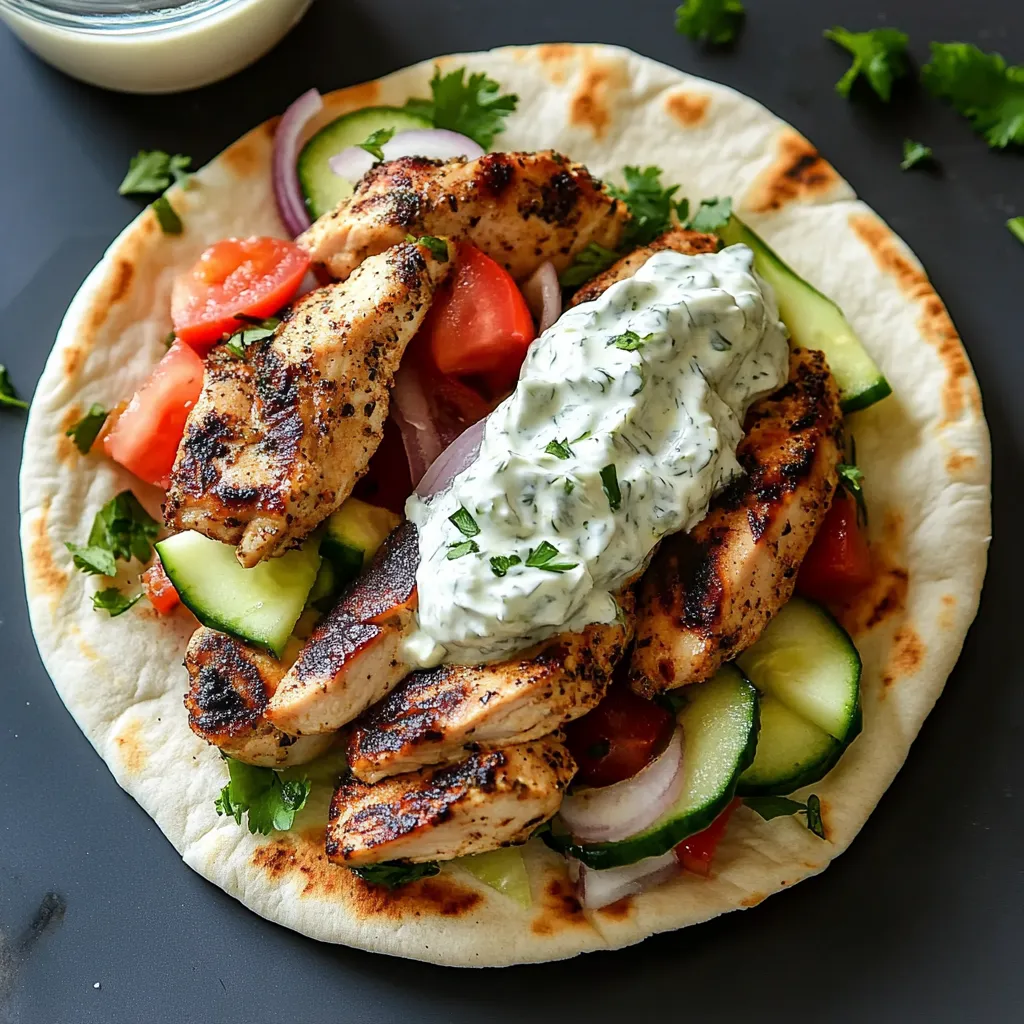 Pin it
Pin it
Tender strips of fragrant chicken nestled in warm pillowy pita bread create a handheld Mediterranean feast that transports your taste buds straight to Greece. The magic happens when garlic and lemon infused chicken meets cool, creamy tzatziki sauce alongside crisp vegetables and tangy feta cheese. This perfect harmony of flavors and textures creates an incredibly satisfying meal that manages to feel both indulgent and wholesome simultaneously. The beauty of these homemade gyros lies in their balance, with each component playing an essential role in creating that authentic Greek street food experience without leaving your kitchen.
I first encountered authentic gyros during a coastal vacation in Greece where local tavernas served these handheld delights with ingredients so fresh they needed minimal preparation. What struck me most was how the simple marinade transformed ordinary chicken into something extraordinary. After returning home, I spent months perfecting this recipe, discovering that allowing the chicken to marinate overnight creates significantly more flavorful results that truly capture the essence of those Mediterranean memories.
Perfect Ingredients
- Chicken breast: Choose plump, evenly sized portions and slice them against the grain into thin strips before marinating, creating more surface area for flavor absorption while ensuring tender, quick cooking pieces.
- Fresh lemons: Select heavy fruits with thin, smooth skin for maximum juice yield, using both juice and zest to infuse the chicken with bright citrus notes essential to Greek cuisine.
- Greek oregano: Look specifically for Greek varieties with their more robust, earthy profile compared to Italian oregano, providing the distinctive herbal foundation for authentic flavor.
- Greek yogurt: Use authentic full fat Greek yogurt with its thick, creamy texture and tangy flavor that serves as the perfect base for tzatziki while providing protein and calcium.
- English cucumber: These seedless cucumbers have thinner skin and fewer seeds than regular varieties, creating tzatziki with better texture and less excess moisture.
- Fresh dill: Select bright green, feathery fronds with no yellowing or wilting, chopping finely to distribute their distinctive anise like notes throughout the tzatziki.
- Feta cheese: Traditional Greek feta made from sheep's milk offers the perfect crumbly texture and sharp, briny flavor that balances the other components perfectly.
- Pita bread: Look for authentic Greek style pita that's thicker and fluffier than Middle Eastern varieties, with the perfect pliability for wrapping without tearing.
 Pin it
Pin it
Preparation Perfection
- Flavor infusion:
- Combine olive oil, lemon juice, minced garlic, oregano, and cumin in a bowl large enough for the chicken, whisking thoroughly before adding sliced meat to ensure even distribution of aromatics.
- Complete coating:
- Massage marinade into chicken pieces with your hands, ensuring each strip is completely covered before covering the bowl and refrigerating for proper flavor development.
- Patient marinating:
- Allow chicken to absorb flavors for at least four hours or ideally overnight, turning occasionally to ensure even flavor penetration throughout the meat.
- Cucumber preparation:
- Grate cucumber on the large holes of a box grater, then place in a clean kitchen towel and squeeze firmly to remove excess moisture that would water down the tzatziki.
- Proper cooking:
- Heat a heavy skillet until very hot before adding marinated chicken in a single layer without overcrowding, allowing proper browning rather than steaming for maximum flavor development.
- Gentle warming:
- Heat pita bread briefly on a dry skillet or wrapped in foil in the oven just until soft and pliable without crisping, maintaining its perfect texture for wrapping.
- Thoughtful assembly:
- Layer components strategically, placing meat first followed by vegetables and cheese, with tzatziki added last to prevent soggy pita and maintain distinct flavors in each bite.
My Greek neighbor taught me the importance of patience when marinating meats for traditional dishes. She explained that proper flavor development requires time for the acidic components to tenderize the protein while the herbs and spices fully infuse. When I first attempted this recipe, I rushed this step and while the gyros were good, they lacked depth. The next time, I followed her wisdom and marinated overnight, discovering a transformation in flavor that made all the difference between an adequate meal and an extraordinary one that truly captured the essence of Greek cuisine.
Wonderful Variations
Adapt this versatile recipe to suit different preferences and dietary needs while maintaining its authentic character. Create a vegetarian version by substituting the chicken with grilled halloumi cheese or marinated portobello mushrooms using the same herb and lemon infusion for consistent flavor profiles. Transform the presentation into a family style gyro bowl with components arranged separately over a bed of lemon herb rice, allowing diners to create their perfect combination while making the meal more fork friendly. For gluten free diners, serve the seasoned chicken and toppings over a crisp Greek salad with extra tzatziki as dressing, maintaining all the signature flavors without the pita.
 Pin it
Pin it
Frequently Asked Questions
- → Can I make these Greek Chicken Gyros ahead of time?
- Yes! You can prepare all the components ahead of time and assemble just before eating. The chicken can be marinated up to 24 hours in advance and cooked up to 2 days ahead (store in an airtight container in the refrigerator). The tzatziki sauce actually tastes better after sitting in the fridge for a day, allowing the flavors to develop. Chop the vegetables the morning of, and then just warm the pita bread and assemble when you're ready to eat.
- → How can I make this recipe gluten-free?
- To make gluten-free Greek Chicken Gyros, simply substitute the regular pita bread with gluten-free pita bread or gluten-free wraps. Alternatively, serve the marinated chicken, vegetables, feta, and tzatziki over a bed of rice or as part of a Greek salad with lettuce as the base. All the other ingredients in the recipe are naturally gluten-free, but always check your spice labels to be sure they don't contain any gluten-based additives.
- → What sides pair well with Greek Chicken Gyros?
- Greek Chicken Gyros pair wonderfully with traditional Mediterranean sides like Greek salad, tabbouleh, or a simple cucumber and tomato salad. Roasted lemon potatoes, rice pilaf, or crispy oven-baked fries with oregano make delicious starchy sides. For something lighter, try a side of marinated olives, hummus with raw vegetables, or a small cup of avgolemono (Greek lemon soup). A glass of crisp white wine or a light beer complements these flavors nicely.
- → What's the best way to warm pita bread?
- The best way to warm pita bread is in a dry skillet over medium heat for about 30 seconds per side. This gives you slightly crispy edges but keeps the bread pliable enough to fold. You can also warm pitas in a 350°F oven wrapped in foil for about 5 minutes, or directly on the rack for a slightly crispier texture. For a slight char that adds flavor, hold each pita with tongs directly over a gas flame for a few seconds per side. Avoid microwaving pitas if possible, as they tend to become tough rather than soft.
- → Can I use chicken thighs instead of breast meat?
- Absolutely! Boneless, skinless chicken thighs are an excellent substitute for chicken breasts in gyros. Thigh meat is naturally juicier and more flavorful, and it's more forgiving if slightly overcooked. The marinade time remains the same, but you might need to adjust the cooking time slightly - usually an extra 1-2 minutes per side, depending on thickness. Make sure thighs reach an internal temperature of 165°F for food safety, just like chicken breasts.
